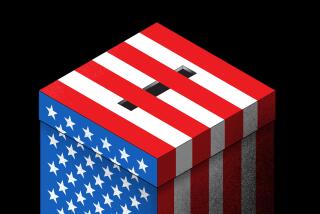The Lieberman Test for Multiethnic America
The leading presidential candidates are telling us that religion has a legitimate role to play in U.S. politics and public life. Vice President Al Gore and Texas Gov. George W. Bush have both endorsed the idea of forging stronger bonds between government and religious faith. With even greater fervor, Sen. Joseph I. Lieberman, Gore’s running mate, has called on Americans to dedicate themselves and their nation “to God and God’s purpose.” Yet, despite all the talk of the Almighty in the 2000 campaign, its implications for public policy are far from clear. Moreover, rules of a faith, such as the restriction on intermarriage in Lieberman’s religion, raise sensitive questions for America’s evolving multiethnic society.
Religion had long been considered a largely private matter. It was one of the two topics--politics is the other--not to be broached in polite company. But the wall separating the public and private has steadily crumbled. In 1960, when John F. Kennedy’s Catholicism threatened to become an issue in his presidential campaign, he defused it by separating his private beliefs from his public duties. By contrast, Lieberman has actively injected the issue of his faith into the campaign. He has thrust the personal into the public realm.
Yet, declaring one’s belief in God is only the most elementary form of religious faith. Polls indicate that more than 90% of Americans profess such a belief. But religion is more than the universalist platitudes the political candidates repeat. It is a system of communally celebrated rituals, rites and rules. Sectarian by definition, it demands that believers adhere to certain tenets and behavioral proscriptions that may run contrary to the values of a secular and pluralistic society. As such, religion is a lot more difficult to integrate into the act of governing than the candidates seem willing to concede.
Just how difficult it can be was illustrated by Lieberman himself. In an apparent retreat from a widespread Jewish concern, even among nonreligious Jews, about intermarriage and the threat it poses to Jewish continuity, he recently told talk-radio host Don Imus that he believes his religion does not restrict Jews from marrying non-Jews. His declaration, which his campaign affirmed, may come as news to much of organized Jewry and to his family, as well. Earlier this month, it was reported that Lieberman made clear to his two grown children that they should date only Jews, who, in America, are as much an ethnic as a religious group. The Connecticut senator also serves on the board of directors of the Orthodox Union, an organization that prides itself on its “proven record of leadership in fighting assimilation and intermarriage.” The organization’s head, Mandell I. Ganchrow, has referred to intermarried Jews, who make up fully half of American Jewry, as “ignorant Jews.”
Lieberman’s faith, Modern Orthodox Judaism, is itself a hybrid of tradition and modernity. Unlike the ultra-Orthodox, who choose to live largely segregated lives in America, Modern or Centrist Orthodox Jews seek to wed a literal belief in Jewish Scripture with the demands and diversity of contemporary life. His Judaism encourages Lieberman to hone his admirable skill of blending personal faith and politics. It may also have imbued him with his evident appreciation for U.S. pluralism and the ideology of inclusion that undergirds it.
To be sure, the restriction on intermarriage that Lieberman has abandoned is in no way improper. He and any other American has every right to adhere to his personal beliefs regarding intermarriage. But the rub comes when an adherent to what can be considered an ancient tribal principle seeks to represent all Americans in an executive office. Some would contend that officeholders’ religious views are irrelevant as long as they don’t strive to impose them on all Americans. But national political figures are role models for citizens in a way that other elected officials are not.
No one has spoken to this point more eloquently than Lieberman himself. In his 1998 floor speech condemning President Bill Clinton’s conduct in the Lewinsky affair, he argued persuasively that “the president is a role model. And because of his prominence in the moral authority that emanates from his office, sets standards of behavior for the people he serves.” This symbolic responsibility, Lieberman’s campaign seems to be saying, also extends to the vice presidency.
Were he a vice president affirming his opposition to Jewish intermarriage, the personal would surely be a matter of debate for the public square. By force of his moral authority as vice president, would Leiberman have validated the old-fashioned notion that intermarriage, ethnic as well as religious, is a wrong choice for Americans? After nearly 200 years of the enforced segregation of the races, America is at long last beginning to rid itself of its onetime legislated opposition to intermarriage. As uncomfortable as it is to watch Lieberman publicly distance himself from his personal beliefs, his abandonment of his faith’s barriers to intermarriage sends a positive message to the nation.
Lieberman’s predicament and its resolution also underscores the need for a new approach to dealing with American diversity. The battles between tribalism and pluralism, separatism and integration, are far from over, and the great wave of post-1965 immigration makes the search for strategies all the more urgent.
The dramatic rise in intermarriage over the past generation is clearly one of the most promising trends in the history of U.S. race relations. While the success of U.S. pluralism doesn’t depend on biological mixture, there is no question that the intermingling of peoples of a variety of backgrounds strengthens the national culture. Intermarriage is not only a sign that a person has transcended segregation, either coerced or self-imposed, it is also the most potent illustration of the extent to which ethnicity no longer serves to separate one American from another.
To be fair, former presidents and vice presidents no doubt opposed intermarriage of faiths and races. For example, the historical legacy of white supremacy and Christian preeminence would have forbidden America’s chief executive from marrying anyone who was not white and Christian. Last February, Bush’s controversial appearance at Bob Jones University raised the issue of interracial dating, which the university had banned. A diversifying America, he learned, can no longer afford to validate such strict boundaries among groups if the nation’s experiment in pluralism is going to succeed.
Ironically, multiculturalism, the ideology promoting the co-existence of separate but equal cultures, is almost as obsessed with cultural and ethnic purity as the segregationism that preceded it. While the triumph of multiculturalism has fostered a healthier awareness of the cultural contributions of minority Americans, it has also engendered the parochial view of ethnicities as static, hermetically sealed museum pieces.
It is well and good to celebrate diversity and the continuity of minority cultures. But it is even more important to acknowledge the alternative process by which Americans of varied backgrounds intersect, metamorphose and create a hybrid America. According to one estimate, 21% of the U.S. population will claim mixed ancestry by 2050, meaning some combination of black, white, Latino and Asian. Accordingly, the most multiethnic country the world has ever known needs to move beyond multiculturalism toward a new ideology of hybridity that enables us to negotiate our brave new amalgamated world.
At the very least, Americans would do well to respect their mixed future even as they honor their cultural traditions. With the U.S. scheduled to become a majority nonwhite nation sometime around mid-century, we need to figure out how to make a diverse nation hold together in a world of disappearing boundaries. Now that we’ve become so good at highlighting ethnic diversity, we may one day see fit to publicly celebrate ethnic impurity.
More to Read
Get the L.A. Times Politics newsletter
Deeply reported insights into legislation, politics and policy from Sacramento, Washington and beyond. In your inbox three times per week.
You may occasionally receive promotional content from the Los Angeles Times.






